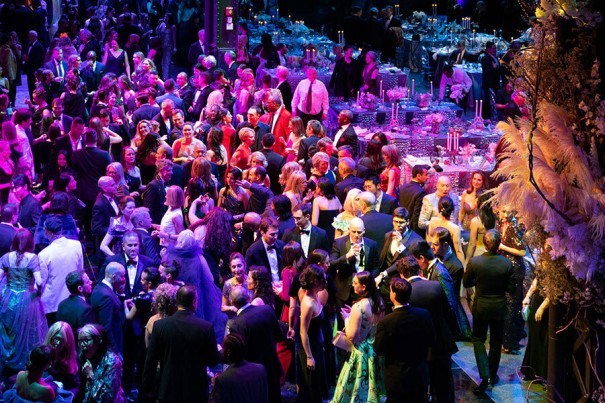How The Upcoming Boston Ballet Ball, “Flora,” Is Blossoming Into The Most Stunning Party of 2024

/ Flavio Photography
Every year, Boston Ballet transforms a spectacular city venue into a fairytale-scape for one of the biggest parties of the year—the Boston Ballet Ball. This signature fundraising event supports the Company’s many valuable programs, allowing the non-profit organization to make the beauty of dance accessible to our community and beyond. With its high glamor, live performances, and creative black-tie dress code, it’s also one of the city’s most entertaining nights of the year.
On February 10, Bostonians and ballet-lovers alike will enjoy the glitzy celebration, but for the Company, this year’s event is a notable one. That’s because Boston Ballet is celebrating their 60th anniversary, and they’re commemorating their evolution and bright future with a special theme: “Flora.”
We spoke with two Boston Ballet trustees who are leading this year’s Ball, Chair Laura Sen and Vice Chair Brynja Vifilsdottir, as well as Artistic Director Mikko Nissinen, to discover how “Flora” will come to life at the event—and the deeper meaning behind it.

/ Flavio Photography
The Blossoming of the Ball
As you can imagine, the “Flora” theme for the 2024 Boston Ballet Ball has sprouted plans for stunning visuals. “From the minute you walk into the venue, you should be embraced with the theme,” says Vifilsdottir.
The event’s aesthetic will be inspired by ornate visuals from Medici-era architecture and design in Florence. The result: A Renaissance-like dreamscape complete with dusty florals and accented by architectural detail that one can only find in 15th century Italian piazzas.
Sen says the team has unforgettable details planned that will transform the SoWa Power Station’s industrial bones into a microcosm of the Boston Ballet universe, revealing not only its aesthetic grandeur but also the Company’s most essential values—the horticultural implications of “Flora” suggest the importance of growth and change, as well as the vitality and beauty that diversity brings.
Guests will be immersed in this fantasy not only by the atmosphere, aesthetics, and symbolic elements, but also with two live performances—one of which will be commissioned especially for the event. “We’re inviting people into our world,” says Vifilsdottir.
60 Years of Cultivation Through Education
If you carefully tended a flower garden for 60 years, caring for the soil, planting new seeds, and watching the plot grow year after year, imagine the biodiversity and beauty you’d create. That’s how Nissinen and the Company see “Flora”—the culmination of 60 years of performance and education.
The Company has been sowing new seeds since its founding in 1963, and its commitment to sharing the performing arts with all audiences and students (E. Virginia Williams founded Boston Ballet School the same year) has never wavered.
In 1991, the Company introduced Citydance, a program that visits Boston Public Schools with a tuition-free foundational dance program for more than 3,000 third grade students that continues to inspire new arts lovers each year.
About a decade later, they launched Adaptive Dance, the year-long program that offers specialized instruction for aspiring dancers with Down Syndrome and Autism Spectrum Disorders. “We are pioneers when it comes to developing a dance curriculum for children with special needs,” says Vifilsdottir.
Today, the Company is committed to making ballet accessible to and enjoyable for all, cultivating and caring for those seeds they sowed throughout their history. But their education and community programs are just the beginning—accessibility and inclusion have stakes beyond the classroom and studio.
Inviting Change to the Stage
According to Nissinen, healthy cultivation of the organization requires openness to change on-stage. In fact, the way he puts it, they’re “revolutionizing ballet” as they forge ahead into their next 60 years.
The Boston Ballet Ball will celebrate that bright future, and also put past seasons in retrospect, revealing a timeline rich with talent and cultural relevance. “Any time there’s an anniversary, it’s a good time to exhale and take a look at the past,” says Nissinen.
The Company’s first performance was “Don Quixote” in 1965 at the Falmouth Playhouse. By the 1970’s, in step with the cultural moment, the Company put on an inventive rock ballet while mastering classics like “The Sleeping Beauty” for the first time (which they also performed in their 2022-23 season). The Company then joined the global stage in the 1980’s with tours across the world to London, China, and beyond.
More recently, Nissinen says, the Company has been working to uplift historically underrepresented artistic voices, and the future of the Company is already unfolding with that goal at center-stage. Helen Pickett, who got her start at Boston Ballet in 2005 and who will return in 2024 for their Winter Experience program, will bring a world premiere in addition to her stunning work “Petal” to the stage this season. Ken Ossola will bring his world premiere, inspired by Michaelangelo’s “non-finito” sculptures housed in Florence, to Spring Experience in May.
Earlier this season, Boston Ballet pushed the boundaries of the artform with a world premiere from Company dancer My’Kal Stromile named “Form and Gesture,” in which he experiments with classical ballet movement in unexpected ways.
The Company has also blazed a trail to culturally significant ballet works through some of their most recent world premieres like Nanine Linning’s “La Mer,” a commentary on ocean pollution for which the Company collaborated with Woods Hole Oceanographic Institution in Cape Cod. “We’re trying to do something that is so new to our industry,” says Nissinen.
Nissinen has also been working with the Company to refine and, often, re-choreograph canonical works whose artistic depictions no longer stand the test of time. For Nissinen’s upcoming world premiere of “Raymonda,” he’s working with former Danseuse Étoile of the Paris Opera Ballet Florence Clerc to eliminate problematic acts, rearrange classical variations, and simplify plots so that everyone in the audience can relate to and appreciate the story. “It’s very important to look at these works and assess them through today’s lens—and our values,” he says.
Fundraising events like the Ball are what make these new and re-envisioned works possible, and the “Flora” theme is indicative of the importance of inclusion. “There are hundreds of different species of flowers,” says Sen. “We want to be inclusive and diverse—this whole Flora theme is about abundance, it’s about beauty, and it’s about something that everybody can relate to.”
Introducing never-before-seen works to the Company’s repertoire—planting new seeds in the garden, if you will—primes the Company for even more abundance and growth. “You have to have fertile soil,” says Nissinen. “It’s a commitment to that complete process of evolution and caretaking, and paving our way to the future.”
This is a paid partnership between Boston Ballet and Boston Magazine



